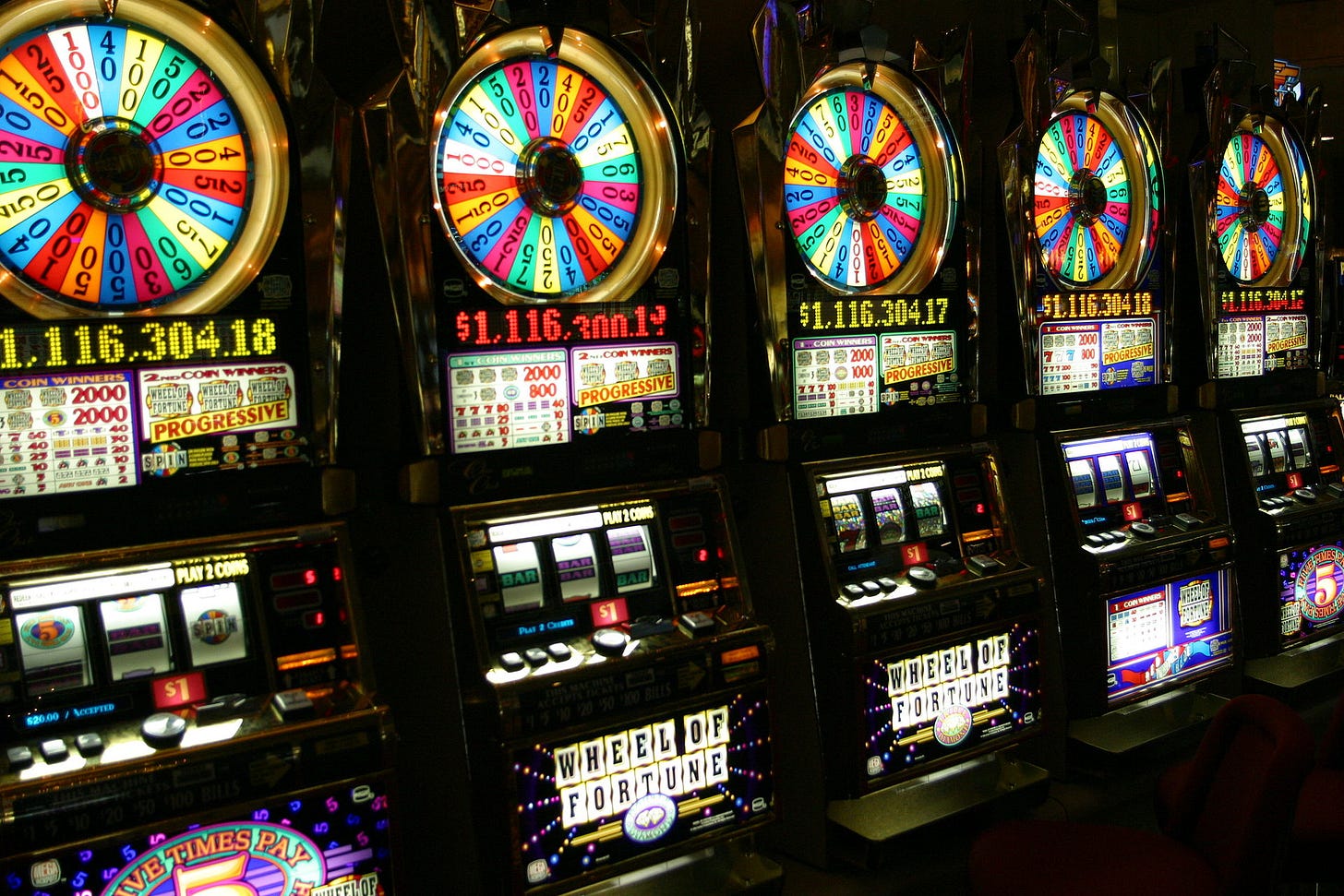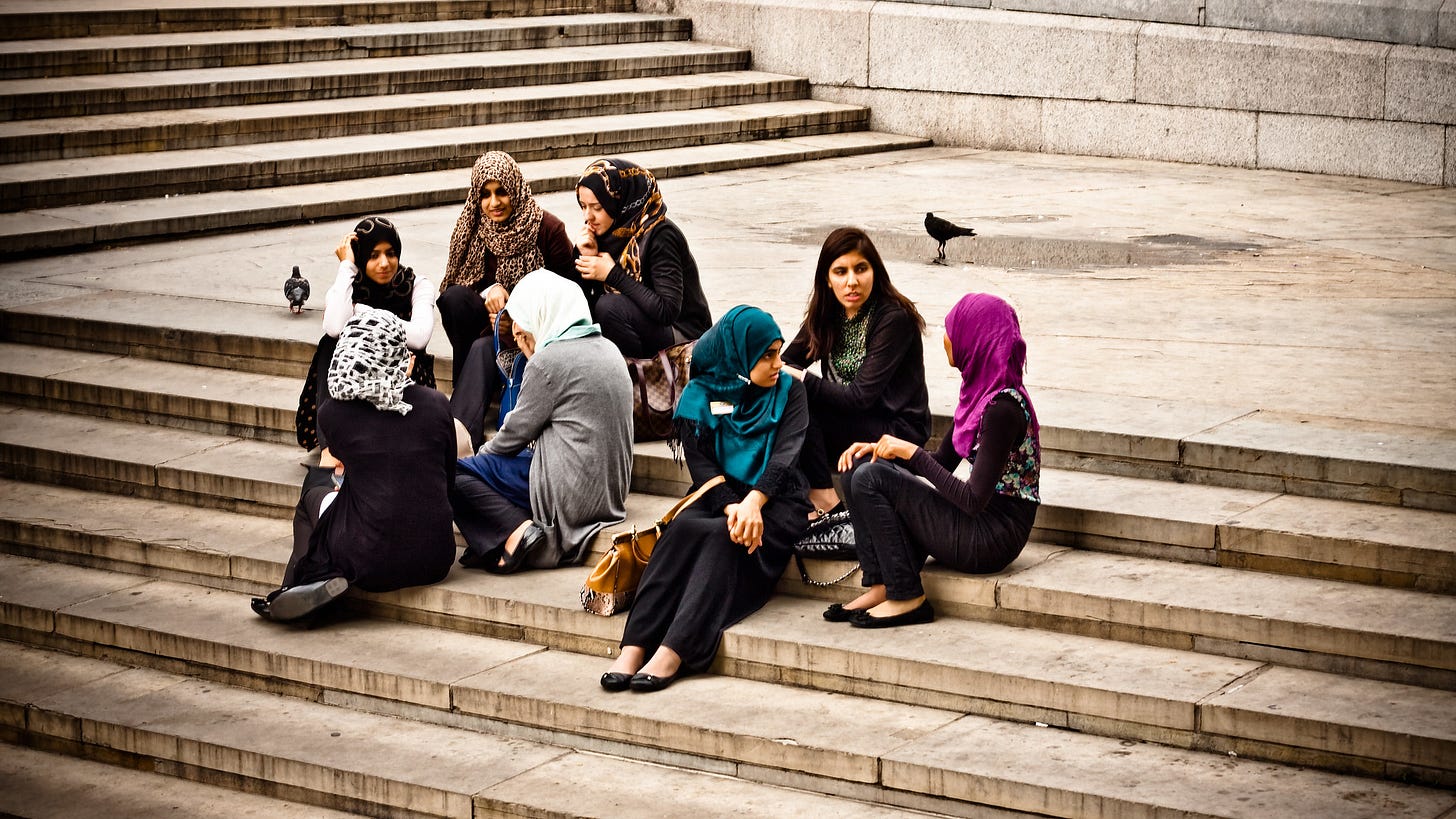Welcome to Just Two Things, which I try to publish daily, five days a week. Some links may also appear on my blog from time to time. Links to the main articles are in cross-heads as well as the story.
Peter Curry writes: A couple of months ago, I was idly curious about something: What makes people addicted to things? If you stop and think about it for a moment, this question quickly becomes hideously complicated. Well, there are different types of addiction, and it’s uh, something to do with the brain, and environmental cues, and flashy lights, and I quickly got bored listening to myself and went to doomscroll reddit.
But the main question of this piece is much more elegant, and much easier to approach than my question: What makes people addicted to slot machines?
(A row of Wheel of Fortune slot machines in a Las Vegas casino. Photo by pcb21, CC BY-SA 3.0, via Wikimedia Commons).
Scott Alexander’s newsletter, Astral Codex Ten, has been running an extended book review competition, and one of the many finalists was a review of a book called Addiction by Design: Machine Gambling in Las Vegas, by Natasha Dow Schüll. The review opens with an ominous introduction on machine gambling:
”Machine gambling is not like other kinds of gambling… Machine gambling is deforestation ruining the rainforest of diverse table games. Machines are invasive kudzu outcompeting and killing the native table games. Machine gambling is the crack cocaine to table games’ cocaine.”
Once you enter the casino, there’s a whole world of engineered tools to keep you using the slot machine. Here they are, laid out back to back in bullet-point form:
Casinos don’t have windows or clocks, to encourage you to lose track of time.
Casinos are filled with bright lights and loud sounds to overstimulate you and worsen your decision making.
Games are designed to be fast, so you can play more of them (Bally aims for 3.5 seconds a game).
Cards are chosen over coins so that you don’t feel like you’re spending real money.
'Near misses’ are added to games so that the gambler feels like they were ‘close’ to winning big.
Teaser strips are added, animations of wheels loaded with winning symbols. These disappear when the reels stop spinning.
Slot machines have a ton of possible lines to bet on. This increases the number of near misses you see. One of the lines is probably going to win, so you should have bet on that one.
Losses disguised as wins’ is a strategy which involves playing all of the overstimulating lights and sounds even when you lose.
Slot machine patterns are ‘reel mapped’, meaning that winning symbols appear directly above or below where you needed them to much more often than they should.
Okay. That’s a lot of hi-tech addiction machinery. But even with all of that, I doubt many people who use a slot machine once will inevitably find themselves compulsively playing deep into the grey hours. Most of us are capable of resisting the slot machine’s fatal attraction, so what’s the point? Well, usually gamblers are trying to enter something called “the zone”.
”The primary objective that machine gambling addicts have is not to win, but to stay in the zone. The zone is a state that suspends real life, and reduces the world to the screen and the buttons of the machine. Entering the zone is easiest when gamblers can get into a rhythm. Anything that disrupts the rhythm becomes an annoyance. This is true even when the disruption is winning the game. Many gamblers talk about how winning the game brings them out of the zone, and they actually dislike winning for that reason.
For some gamblers, the very act of pressing buttons to play the game disrupts the rhythm. These gamblers use autoplay modes on games that offer them, and jerryrig an autoplay mode on machines that don’t, by jamming something into buttons to keep them pressed. They don’t want to chase a win or pick their lucky numbers, they want to disappear into the zone.”
In this light, slot machines only need to have the addiction machinery in order to create the zone. And the zone is what is making many gamblers play, because they’re not happy with their lives, and they want to escape into the same sensation that many of us are trying to escape into when we’re doomscrolling, or gaming or drinking.
They’re trying to enter a state where they don’t have to think about the world.
The review continues on to discuss where to apportion blame for gambling, which is interesting (teaser: casinos want to blame gambling on genetics), but this is already too long, so I’ll stop here.
But it’s worth thinking about gambling in a systemic lens—changing the rules about how addictive slot machines are allowed to be is a useful step. But the real end goal should be helping people to feel happy and to find connection and meaning in their lives. If you can do that, the regulation might become less important.
#2: Depicting Muslims
My former colleague Mouna Kalla-Sacranie has a great piece on her Medium page on a missing media trope: ‘the happy Muslim’.
(Young Muslim women in Trafalgar Square, London. Photo by Garry Knight, Flickr, CC BY 2.0).
She’ll explain it better than I will:
Scroll through Netflix or Prime and you’ll soon discover just how rare it is to see a Muslim character (male or female), who wears their faith lightly; whose belief in Islam, although unwavering, is simply a minor plot point, as opposed to the entire axis upon which their character is built. That’s because when showrunners insert Muslim characters into their shows in the name of ‘inclusion’, they almost exclusively depict individuals who have a fraught and uneasy relationship with their faith ... This is telling.
As she says, of course it’s the case that there are Muslims who do have a fraught relationship with their faith. It’s not that this representation is wrong. It’s just that so much gets chopped off by this particular frame.
We see this in other places too... In the same way that non-Muslim executives sit in a room and write a script about a Muslim man praying in a toilet cubicle or a Muslim woman breaking her fast with a shot (two things that believe me, are very rare), non-black TV execs default to stories of black people facing and/or overcoming racism, because the only concept of blackness they can conceive of is one that is intrinsically linked to racial injustice and suffering.
There are some exceptions, at least in some of the stories told about black people. Mouna highlights Insecure, for example.
Does this matter? It’s only television, after all. But yes, it does matter—of course it matters—because our views of what the world is like are normalised by the way the world is reflected back to us through mass media. (Think of the ways in which perceptions of Britain’s ethnic and immigrant communities were distorted by the endless hostile newspaper coverage during the Brexit campaign, and after it.)
But Mouna says this more elegantly than I can:
Depicting someone who is happily Muslim is not about putting identity politics over entertainment value. Nor is it about robbing film and television of vital plot devices. ... It is about offering these characters, and those watching them, wholeness — a space to be, and be seen, as nuanced, human, mundane and ordinary.
It’s not a long piece. Do read it.
Update: I mentioned a couple of weeks ago the community futures pilot that SOIF had run in Wales with WCVA. The Toolkit — which outlines the process — has now been published (pdf).
j2t#110
If you are enjoying Just Two Things, please do send it on to a friend or colleague.




